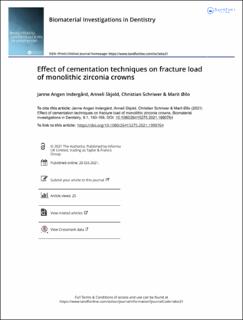Effect of cementation techniques on fracture load of monolithic zirconia crowns
Journal article, Peer reviewed
Published version

Åpne
Permanent lenke
https://hdl.handle.net/11250/2825938Utgivelsesdato
2021Metadata
Vis full innførselSamlinger
Originalversjon
Biomaterial Investigations in Dentistry. 2021, 8 (1), 160-169. 10.1080/26415275.2021.1990764Sammendrag
The aim of this study was to evaluate the effect of cement on the fracture load of monolithic zirconia crowns with different yttria content (3 and 5mol%). A total of 62 monolithic zirconia crowns, 40 3Y-zirconia crowns (Prettau®Zirconia, Zirkonzahn) and 22 5Y-zirconia crowns (Prettau® 4 Anterior®, Zirkonzahn) were produced to a shallow chamfer molar preparation. The 3Y-crowns were divided into four groups and attached to composite abutment duplicates (SDR® flow+, Dentsply DeTrey GmbH) using the following four cementation techniques; 1: Self-adhesive resin-based cement, 2: Pre-treatment with air-abrasion and self-adhesive resin-based cement, 3: Zinc phosphate cement 4: Glass-ionomer cement. The 5Y-crowns were divided into two groups and attached to the duplicates with; 1: Self-adhesive resin-based cement, or 2: Air-abrasion pre-treatment and self-adhesive resin-based cement. All crowns were loaded axially (0.5mm/min) on the occlusal surface until fracture occurred. Among the 3Y-zirconia groups, the zinc phosphate cement group fractured at lower loads compared to the resin-based cement groups, with and without air-abrasion, (p
